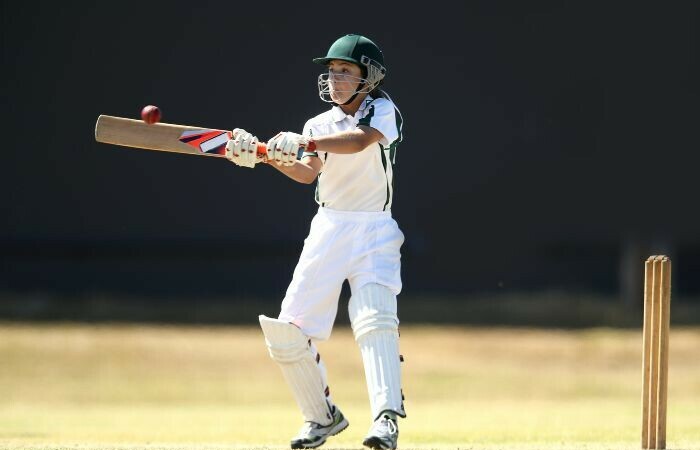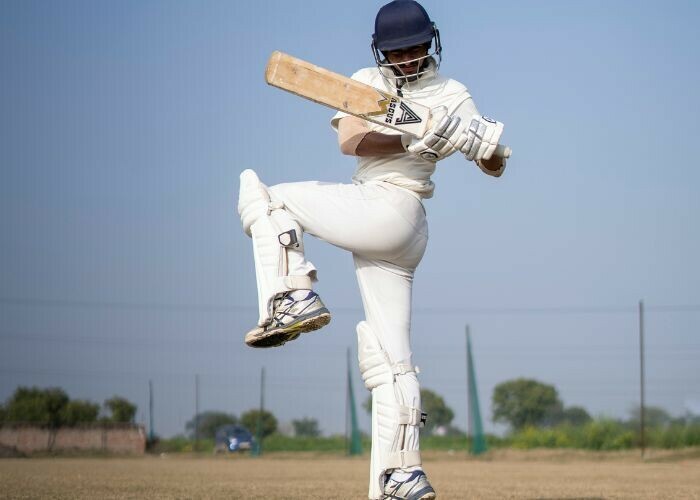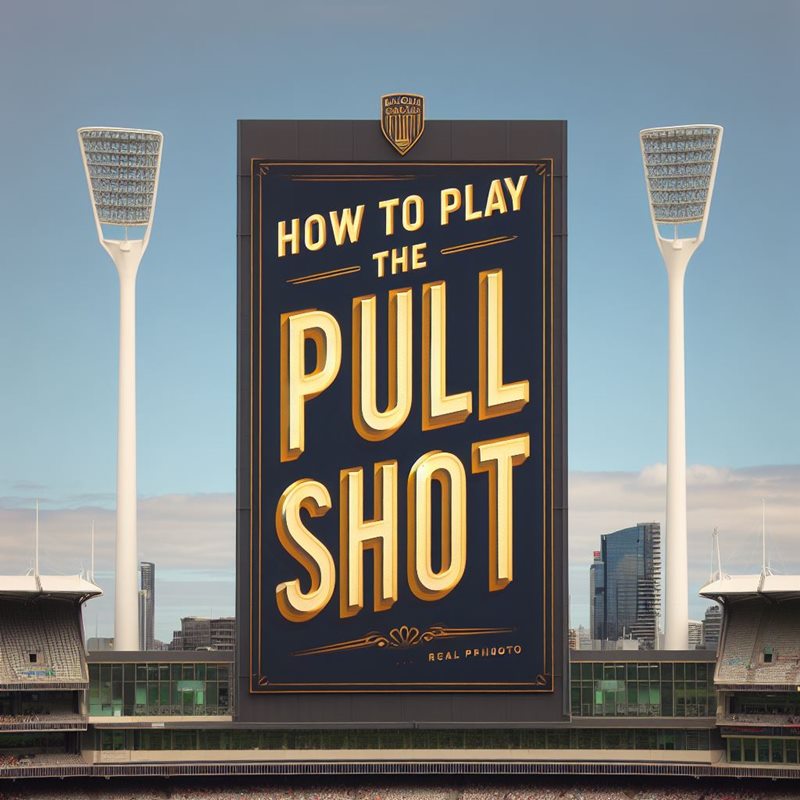The pull shot is one of the most exhilarating and potent strokes in the game of cricket. Not only does it epitomize the batter’s skill and timing, but also their audacity in taking on fast bowling with an aggressive mindset.
To put it into one sentence, the pull shot involves the batter swivelling on their back foot and hitting a short-pitched delivery pitched with a horizontal bat to the leg side. It is a cricket shot that demands precision, power, timing and a bit of daring and bravery.
The strategic importance of the pull shot cannot be overstated. In modern cricket, where bowlers continually experiment with line, length and pace, the ability to execute the pull shot allows the batter a significant edge. It forces bowlers to alert their lengths and strategies, which can create scoring opportunities elsewhere.
If you, as the batter, can include the pull shot in your repertoire and execute it with skill and consistency, it can demoralize the opposition’s bowling attack, shifting the game’s momentum in favour of the batting team.
Perfecting the pull shot is more than just merely the physical requirements to make the shot; it is about making a psychological statement. As the batter, you are sending a clear message as to your intent and readiness to dominate the bowler.
A Technical Deep Dive Into The Pull Shot
Mastering the pull shot begins with understanding the fundaments of what makes it both effective and formidable.
Optimal Stance and Positioning for Impact: The optimal stance for a pull shot involves being slightly back in the crease with your weight balanced more on your back foot. This position allows you to generate maximum power from the legs and hips, which is crucial for pulling the ball with force.
But unless you can read the bowler’s mind and know he is going to bowl a short ball to you, you have to be able to read the line and length of the ball first before moving into that position, and then, at the point of contact, be balanced and still.
If you move into this position before the ball is bowled, you will miss out on opportunities to drive the ball if it is pitched up. Reading the line and length and then moving into the correct position, is something you will need to work on during your training drills.
Striking the Ball: Timing is arguably the most crucial element of the pull shot. Striking the ball just as it rises near waist height ensures optimal contact and direction. If the ball gets much higher than the waist or chest height, you will need to adjust your shot to the hook shot (discussed in a later post), or sway or duck out of the way of the ball.
If you’re too early on the stroke, or if you are too late, the shot could be mistimed, leading to a catch, or you might miss it, which might lead to the ball striking you in the chest, depending on its trajectory.
Watch the ball closely from the bowler’s hand, determine it’s line and length, predict its bounce and trajectory, and get in the right position.
Bat Swing: The pull shot requires a coordinated effort between the bat path and your body movement. Where you want the ball to go will be determined by the angle of your bat swing and what your wrists do at the moment the ball strikes the ball.
In the longer forms of the game, you are more likely to want to hit the ball along the ground. This will likely mean that your bat swing will come horizontal to the ball ,or from slightly above the ball in a downward arc. At the time of hitting the balls, you should roll your wrists to try and get the ball to ground as quickly as possible.
Of course, in the shorter forms of the game (and sometimes in the longer form as well), you may decide not to hit the ball along the ground, and try to hit the ball into the stands. For this, your bat arc might be slightly from down to up, and you might hit it with a slightly more angled bat to get the elevation you need into the shot.
As with every lofted shot, it comes with risk. If you don’t get the elevation or power you need, it is very easy to hit the ball down a fielder’s throat.
Knowing When to Pull Out the Pull Shot

It’s one thing knowing how to hit the pull shot; it’s another thing knowing when to hit the pull shot. The decision to play the pull shot is as much about timing and precision as it is about selecting the right moment and the right delivery. You need keen observation and quick decision-making; if either one fails, you could easily see yourself getting out caught by a fielder.
Choosing the right ball: Don’t go pulling out the pull shot for every short pitched ball. You need to read the ball as soon as it leaves the bowler’s hand and discern the length and trajectory of the ball as quickly as possible in order to get into the optimal position to make the shot. Ideally, the ball should be short enough that it reaches between your waist and chest.
Any higher, and you won’t have as much control over the shot and it would be almost impossible to get the ball to the ground. Any lower, and the ball is likely to go under your bat or be hit with a bottom edge.
Analysing the bowler: Whether you are facing a spin bowler, a fast bowler or a medium pace bowler, the pull shot is a viable attacking option. However, each bowling type adds pros and cons to the decision making matrix as to whether to pull or not.
When facing against fast bowlers you don’t have much time to determine line and length and then get into position to make the shot. That, obviously, is a con. But the pro is that you don’t have to hit the ball as hard to make it rocket away to the boundary. You can use the bowler’s pace.
For medium pace bowlers, and particularly spin bowlers, you have more time to get into position to make the shot. That’s the pro. The con is that you have to provide more of the power to make the shot effective. And that means more things can go wrong.
These are the kind of things you have to weigh up before determining what kind of shot to play.
Strategies Against Diverse Bowling Styles: Facing a variety of bowling styles calls for adaptive strategies. For instance, if you are facing an express fast bowler who is mixing bouncers with fuller length, you might decide to stay on the back foot, and then adjust for the fuller deliveries.
A slower bowler, though, may not bowl as many short balls, so your first movement may be forward, and then adjusting backwards for the pull shot if you do spot a fuller delivery.
You should practice your movements in the nets, so that it becomes second nature on the cricket pitch.
Common Errors and How to Fix Them
Executing a pull shot correctly and with power, is a challenge, and even seasoned players can slip into common errors.
One frequent mistake is poor timing; this is usually caused by taking your eyes off the ball too early, or misjudging the length. This can lead to top edges or mistimed shots that go straight down the throats of fielders.
A second common error is incorrect weight distribution. If you lean back too much or fail to transfer your weight to the back foot correctly, the result can be a lack of control and power in the shot.
To overcome those issues, there are some specific drills and techniques you can use. To fix timing issues, have a coach or a partner bowl – or feed the bowling machine – short balls that can help you practice watching the ball onto the bat and perfecting the swing.
To correct incorrect weight distribution issues, practicing the shadow batting technique without a ball can help. Here, you should repeatedly perform the pull shot motion, focusing on the smooth transfer of weight to get into the correct position for the shot, ensuring you have a stable base throughout the shot.
Practicing to Perfection

Developing a commanding pull shot requires deliberate practice and strategic exercises that focus on refining technique, power and adaptability under various conditions.
Specific drills are fundamental for enhancing your pull shot. One drill uses a partner or a bowling machine to bowl short pitch deliveries, varying the speed and bounce of the deliveries unpredictably. This will help you adjust your stance and timing quickly, mimicking real-life scenarios.
Similarly, you can adapt to different speeds and bounce scenarios by having your partner, or the bowling machine, deliver are wide array of balls, not all of them short. In a real game, the short ball may be used as a surprise weapon, so you need to see it and adjust to the line and length of the delivery without knowing what the delivery will be before hand.
Additionally, practicing on different types of pitches – fast and bouncy, slow and low, spinning pitches – will help you prepare for all conditions.
And if you don’t have someone to practice with, you can still practice alone. Set up a cricket ball in a sock. When the ball swings back after each hit, this will allow you to practice multiple pull shots in quick succession.
And, of course, the old favourite, shadow batting in front of a mirror can help you self-assess and adjust your body mechanics related to footwork and bat swing.
Last Word on the Pull Shot
The mastery of the pull shot is not solely a matter of physical skill; it also demands a strong mental approach. Confidence is the cornerstone of executing any aggressive cricket stroke, but particularly the pull shot. Confidence comes from repeated practice, but also in your deep-seated belief in your ability to perform the shot effectively under match conditions.
You, as the batter, need to possess in-game intelligence to assess factors like the bowler’s plan, the field setting, and match situation, to recognize the best time to play the shot. Developing this aspect of the game intelligence comes from experience and meticulous study of your own game and opponents.
I hope you have enjoyed this blog post. The next one we’ll do is on the hook shot, which is very similar to the pull, but riskier, due to the fact it is performed against a higher bouncing ball and is harder to control. If you have any stories about a player you’ve seen with a great pull shot, please include it in the comments.

